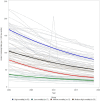Applying group-based trajectory modeling to understand under-five mortality trends and determinants in low-and lower-middle income countries
- PMID: 40426192
- PMCID: PMC12117966
- DOI: 10.1186/s12963-025-00381-1
Applying group-based trajectory modeling to understand under-five mortality trends and determinants in low-and lower-middle income countries
Abstract
Background: Reducing under-five mortality is a global health priority. Countries need specific data on which interventions have the most potential to lead to improvements to inform their programs and policies.
Methods: Group-based trajectory modeling was applied to identify distinct trajectories of under-five mortality from 2000 to 2019 in 78 low and lower-middle income countries. Both health and non-health variables were studied as time-stable covariates of trajectory group membership and as time-varying covariates of mortality rates within groups.
Results: We identified four distinct groups that were primarily distinguished based on trajectory level rather than shape-low mortality, medium mortality, medium-high mortality and high mortality. All four groups had under-five trajectories that declined over time with the highest mortality group having the largest declines. We conducted two sets of bivariate analyses. The first analysis was conducted to understand what factors distinguished the different groups from one another (time stable covariate analysis), and the second analysis was done to understand what factors were significant within a group (time vaying covariate analysis). Results indicated that five factors were associated with all three comparisons of being in the low, medium and medium high groups compared to the highest mortality group. These factors were fertility rate, % of population with an improved water source, female secondary school enrollment rate, diphtheria, pertussis, tetanus dose 3 (DPT3) coverage and % of gross domestic product (GDP) on health expenditures. Results of the modeling of the within group analysis with time-varying factors indicated that higher fertility rates and higher out-of-pocket expenditures were significantly associated with greater mortality rates for all four groups. High DPT3 coverage, greater political stability, high coverage of births in a health facility and a greater % GDP on health expenditures were significantly associated with reduced under-five mortality for all four groups.
Conclusion: Findings from our study revealed the importance of considering both health and non-health factors in understanding trajectories of under-five mortality. In particular the fertility rate and % of GDP on health expenditures were signicant for all three comparisons of the trajectory group membership analysis (time-stable covariates) and were significant for all four groups in the within group analysis (time varying covariates). Other factors were significant for some comparisons and groups. Focusing on a number of key factors relevant to their group could help countries to further improve the health of young children.
Keywords: Group-based trajectory modeling; Low and middle income countries; Under-five mortality.
© 2025. The Author(s).
Conflict of interest statement
Declarations. Ethics approval and consent to participate: Not applicable. (This paper only used aggregated country-level data and did not involve human subjects.) Consent for publication: Not applicable. Competing interests: The authors declare that they have no competing interests.
Figures
References
-
- UNICEF. Levels and Trends in Child Mortality. Estimates Developed by the UN Inter-agency Group for Child Mortality Estimation. New Year. 2021.
-
- United Nations. Sustainable Development Goals https://sustainabledevelopment.un.org/topics/sustainabledevelopmentgoals. Accessed April 5, 2022.
-
- Weiss W, Piya B, Andrus A, et al. Estimating the impact of donor programs on child mortality in low- and middle-income countries: a synthetic control analysis of child health programs funded by the United States Agency for International Development. Popul Health Metrics. 2022;20:2. 10.1186/s12963-021-00278-9. - PMC - PubMed
MeSH terms
Grants and funding
LinkOut - more resources
Full Text Sources


